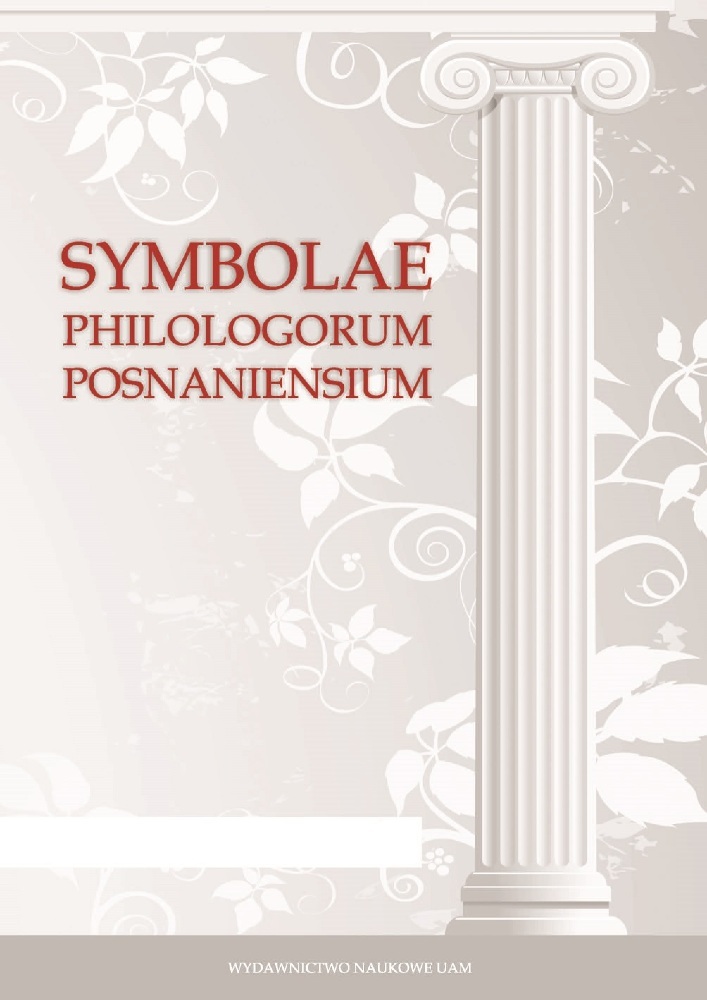Abstrakt
Claudian’s mythological poem De raptu Proserpinae is almost wholly composed of loosely linked episodes. The disputed verses from his epic, are one of the luxuriant descriptive episodes (ekphrasis) and portray four goddesses tending to the meadow of the Mount Etna. In this paper I’ll try to indicate, that their looks and the symbols depicted on their garments resemble the popular fashion of the contemporary aristocracy and remind of the works of art and motifs characteristic and prevailing in fourth century C.E. Beyond that, not to be overlooked, Claudian simultaneously emulates the divine images that mainly appear in Homer’s and Vergil’s epics as well.Bibliografia
Źródła
Klaudian
Hall 1969: Claudian, De raptu Proserpinae, ed. John B. Hall, Cambridge,1969.
Burmann 1821: Claudiani De raptu Proserpinae ed. Peter Burmann, Londyn 1821.
Artaud 1824: Claudiani opera omnia, recensuit N. L. Artaud, Paryż 1824.
Srutt 1814: The Rape of Proserpine with other poems, ed. J.G. Strutt, London 1814.
Autorzy antyczni:
Apollodorus. The Library, Translated by Sir James George Frazer, Loeb Classical Library, Volumes 121 & 122. Cambridge, 1921.
Apollonius Rhodius, The Argonautica, transl. Seaton, 1912, An Electronic Classics Series Publication (http://www2.hn.psu.edu/).
Homer, Iliada, tłum. Franciszek Ksawery Dmochowski, Kraków 1930.
Homer, Odyseja, tłum. L. Siemieński, Gdańsk 2000.
Horacy, The Works of Horace, ed. C. Smart. Philadelphia 1836.
Marcjalis, M. Valerii Martialis Epigrammaton libri, rec. W. Heraeus, Leipzig 1925/1976.
Ovidius P. Naso, Amores, Ars Amatoria, ed. R. Ehwald, Leipzig 1907.
Ovidius P. Naso, Metamorphoses, ed. H. Magnus, Gotha 1892.
Platon, Fajdros, przekł. W. Witwicki, Warszawa 1958.
Statius P. Papinius, Achilleidos libri duo, Schürer 1515.
Vergilius P. Maro, Bucolica et Georgica, ed. H. Ch. Gottlob, Harvard 1821.
Vergilius, Bucolics, Aeneid, and Georgics Of Vergil, ed. J. B. Greenough. Boston,1900.
Wergiliusz P. Maro, Eneida, tł. ks. T. Karyłowski, Gdańsk 1980.
Publikacje internetowe autorów antycznych: http://www.perseus.tufts.edu/
Opracowania
Brown 1980: Peter Brown, Art and Society in Late Antiquity, [w:] The Age of Spirituality: A Symposium, ed. K. Weitzmann, New York 1980, s. 22.
Budziszewska 2011: Nina Budziszewska, Rydwan jako metafora postaci mentalno-cielesnej człowieka, Zeszyty Naukowe Towarzystwa Doktorantów UJ, Nauki Humanistyczne, Nr specjalny 3 (2/2011), s. 208–210.
Cameron 2011: Alan Cameron, The Last Pagans of Rome, Oxford 2011.
Cameron, Long 1993: Alan Cameron, Jacqueline Long, Barbarians and Politics at the Court of Arcadius, Oxford 1993.
Croom 2013: Alexandra Croom, Roman Clothing and Fashion, Amberley Publishing, 2013.
Cytowska 1998: Maria Cytowska, Przyroda w poezji Klaudiana, [w:] Cognoscere causas. Człowiek a natura w cywilizacji starożytnej Grecji i Rzymu, Studia classica et neolatina III, Gdańsk 1998, s.109.
Danielewicz 2006–2007: Jerzy Danielewicz, Opisy posągów w nowo odkrytych epigramach Posejdipposa, ,,Roczniki Humanistyczne”, Tom LIV-LV, zeszyt 3–2006–2007, s. 123–124, 127.
Dominik 1982: William John Dominik, Claudiani De raptu Proserpinae I: A literary Commentary, 1982, s. 64, 67–68.
Dutsch 1992: Dorota Dutsch, Demeter i Persefona, [w:] Mit, człowiek, literatura, red. S. Stabryła, Warszawa 1992.
Gruzelier 2012: Claire E. Gruzelier, Temporal and Timeless in Claudian’s De raptu Proserpinae, ,,Greece and Rome”, vol. 35, 2012, s. 56, 58–59, 69.
Henry 2013: James Henry, Notes of a Twelve Years’ Voyage of Discovery in the First Six Books of the Eneis, Cambridge, 2013, s. 106.
Kellner 1997: Thomas Kellner, Die Göttergestalten in Claudians De raptu Proserpinae: Polarität und Koinzidenz als anthropozentrische Dialektik mythologisch formulierter Weltvergewisserungs, Walter de Gruyter 1997, s. 234, 262–263.
Krause 1858: Johann Heinrich Krause, Plotina, oder die Kostüme Des Haupthaares bei den Völkern der alten Welt: Mit Berücksichtigung einiger Kostüme neuerer Völker in kosmetischer, ästhetischer und artistischer Beziehung, Leipzig 1858, s. 152.
Kenney 1982: Latin Literature, red. E. J. Kenney, Cambridge 1982, s. 708.
Mac Cormack 1976: Sabine G. Mac Cormack, Latin prose Panegyrics: tradition and discontinuity in the late Roman Empire, Revue des etudes augustiniennes, 1976, s. 46.
Malick-Prunier 2008: Sophie Malick-Prunier, Le corps feminin et ses representations poetiques dans la latinite tardive (these pour obtenir le grade de docteur de l’université Paris), 2008, s. 241–242.
Marsengill 2013: Katherine Marsengill, Portraits and Icons in Late Antiquity. Between Reality and Spirituality, Brepols 2013, s. 57.
Mazzara 2003: Federico Mazzara, Persephone: her mythical return to Sicily, e-journal del Dipartimento di Arti e Comunicazioni dell’Università di Palermo, 2003, s. 10–17.
McEvoy 2013: Meaghan McEvoy, Child Emperor Rule in the Late Roman West, AD 367–455, Oxford 2013, s. 162.
Musialska 2003: Ines Musialska, Mit czterech wieków ludzkości u autorów rzymskich epoki cesarstwa, ,,Symbolae Philologorum Posnaniensium” XV 2003, s. 88–90.
Newbold 1991: Ronald F. Newbold, Perinatal Imagery in Claudian, Bulletin of the John Rylands Library, 1991; 73 (1), s. 8.
On the Genius and Writings of Claudian, „The Classical Journal”, tom XXX, London, 1824, s. 12.
Reece 1983: Richard Reece, Art in Late Antiquity, [w:] A Handbook of Roman Art. A Survey of the Visual Arts of the Roman World, ed. Henig M., Oxford 1983, s. 235, 237.
Roberts 1989: Michael Roberts, The Jeweled Style: Poetry and Poetics in Late Antiquity, Ithaca, London 1989, s. 69–70.
Sánchez-Ostiz 2011: Álvaro Sánchez-Ostiz, Antros de horror y lugares de maravilla en la épica de Claudiano, en Actas del VI Congreso de la Sociedad de Estudios Latinos, 2011, s. 316.
Sande 2001: Siri Sande, The Iconography and Style of The Rothschild Cameo, [w:] Late Antiquity: Art in Context, red. J. Fleischer, J. Lund, Museum Tusculanum 2001, s. 146–148.
Svedborg 1860: Ioannes Svedborg, De Claudii Claudiani quod de raptu Proserpinae inscribitur carmine epico quaestiones: Dissertatio academica, Uppsala, 1860, s. 8
Taylor 1875: Thomas Taylor, The Eleusinian and Bacchic Mysteries, New York, 1875, s. 20–21, 88–96.
The Commentary of Geoffrey of Vitry on Claudian “De Raptu Proserpinae”, 1973, s. 57–58.
Ware 2012: Catherine Ware, Claudian and the Roman Epic Tradition, Cambridge 2012.
Ware 2004: Catherine Ware, Gildo tyrannus: Accusation and Allusion in the Speeches of Roma and Africa, w: “Aetas Claudianea”, ed. W.W. Ehlers, F. Felgentreu and S. Wheeler (Leipzig, 2004) s. 96.
West 1992: David West, Translation and Literature, Translating the Aeneid, Vol. 1, (1992), s. 97.
Zanker 1999: Paul Zanker, August i potęga obrazów, Poznań 1999, s. 5.
Licencja
